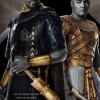[caption id="attachment_311846" align="alignleft" width="480" caption="(Steve F E Cameron, http://en.wikipedia.org/wiki/File:S_F-E-CAMERON_EGYPT_2006_FEB_00289.JPG)"][/caption] Like many other archaic societies, the ancient Egyptian believes that cohabitation of gods and men happened only in the primordial times. For instance, in the Myth of the Heavenly Cow, the ancient Egyptian believed that in the past the gods withdrew to the sky and humankind was left in the earth. Thus, deities were separated from humankind and were not to be encountered and experienced in everyday life. The absence of deities in the world made room for the divine institution that can bridged the humankind to the gods, which is the state. Furthermore, the state in ancient Egypt cannot be separated from religion and especially manifested in temples, as it symbolically substituted “divine” presence in the land of Egypt.
The concept of “divine” itself is quite unique in ancient Egypt. Moreover, there are three central themes on it: the concept of “autochthony”, divine territorial lordship, and the “city god theology”; the concept of temple as imago caeli (image of heaven) and its double function as divine dwelling as well as economic enterprise; and lastly the concept of divine residence on earth as conveyed by image and ritual. Based on the three aforementioned themes, Jan Assmann analyzed that the ancient Egyptians had some local dimension on the “divine realm”. First, they conceived their deities as resident on earth, through the representation in “lordship”, in which the kingdom of the gods was emphatically “of this world”, and the state, which comprises of the kingship and the temple priests, represented the gods. Second, the individual local deity embodied the concept of “city” itself, with their temple acted as the center of the city. As a result, every ancient Egyptian city was always a city of a god. For example, the city of Thebes is also known as “city of Amun” with the god Amun as the city’s “lord”. Interestingly, the concept of ntr niwty (city deity) was one of the earliest elements of ancient Egyptian religion, which was deserted at certain period of time in the Egyptian history, but later predominated again in the end.
Hence, for ancient Egyptians, the concept of city was totally determined by their religion. The “divine dwelling” rank of an Egyptian city was proportionate to its holiness, and its sacred rank was determined by its antiquity. On the other side, the “divine dwelling” ancient Egyptian cities also affected the city dwellers. The city bound people to one another and sedentary life become a summum bonum (ultimate means) of the ancient Egyptian. Therefore, the people’s abandonment of their city (and that also means farm and other economic activities) is considered a big societal loss. So, in order to avoid that disaster to happen, officials of the ancient Egyptian state (royal families and priests) tried to treated peasants in an unassertive way, at least by the standard of their time.
Source: Jan Assmann, The Search for God in Ancient Egypt, (New York: Cornell University Press, 2001), p. 17-27.











